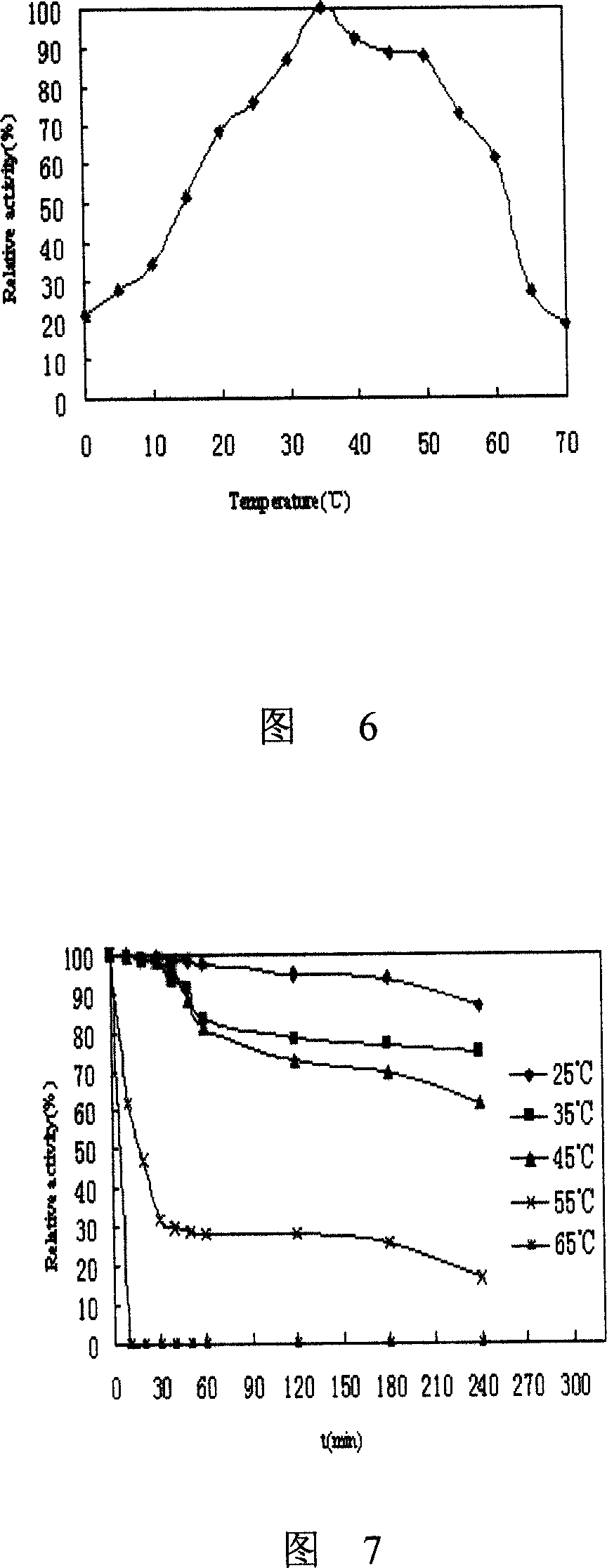Method for producing low-temperature alkaline protease by alternative pseudomonad
A technology of Pseudomonas alternans and protease, which is applied in the field of low-temperature alkaline protease and products produced by Pseudomonas alternans, and can solve the problem of not producing low-temperature alkaline protease
- Summary
- Abstract
- Description
- Claims
- Application Information
AI Technical Summary
Problems solved by technology
Method used
Image
Examples
Embodiment 1
[0072] Example 1. A Pseudomonas alternata HH407 (Pseudoalteromonas flavipulchra HH407) CCTCC NO: M 207009. The strain has the following characteristics: the bacterium can grow at 0°C, the growth temperature range of the bacterium is 0-35°C, and the optimum growth temperature is 20°C; the growth pH range is 5.5-11, and the optimum growth pH is 8.5; The NaCl concentration for growth is 0.5%-13%, and the optimum NaCl concentration for growth is 4%. Without NaCl, it does not grow. It is a typical marine psychrophilic moderate halophilic microorganism; the bacteria can use tryptone, yeast extract, peptone, Cellobiose, starch, gelatin, acetic acid, citric acid, methanol and ethanol.
Embodiment 2
[0073] Example 2. A kind of method that utilizes a kind of Pseudomonas alternata HH407 CCTCCNO described in embodiment 1: M 207009 to produce low temperature alkaline protease, its steps are as follows,
[0074] (1) Inoculate the slant 1 ring of the strain into a 250ml Erlenmeyer flask with 50ml of fermentation medium, 180r / min, 20°C, and cultivate for 16h; insert 2% inoculum into the fermentation medium, 180r / min, 20°C, and cultivate 36h;
[0075] (2) Centrifuge the cultured fermented liquid at 10000r / min for 10min, add 60% ammonium sulfate to the supernatant, let it stand for 3h, centrifuge at 10000r / min for 30min, dissolve it with an appropriate amount of Tris buffer with a pH of 8.0, and then dissolve it at 4°C Dialyze for 24 hours; then obtain low-temperature alkaline protease through DEAE-sepharose Flat Flow and SephacrylS-200 methods.
Embodiment 3
[0076] Example 3. The low-temperature alkaline protease produced by the method described in a kind of embodiment 2, this low-temperature alkaline protease has the following characteristics:
[0077] (1) The optimum action temperature of the enzyme is 35°C, and the catalytic efficiency is still 22% at 0°C; the enzyme is stable at 25°C, 35°C, and 45°C, and the enzyme activity is above 80% at 55°C for 30 minutes after incubation for 60 minutes Loss of 55% enzyme activity; it is a low temperature protease;
[0078] (2) The optimal pH of the enzyme is 10.0, and the relative enzyme activity is more than 80% at pH 9.0-11, and there is enzyme activity at pH 5-12; the most stable pH of the enzyme is 9.0; it is an alkaline protease;
[0079] (3)Sr 2+ 、Ba 2+ 、Cu 2+ , Mn 2+ 、K +Activation of enzymes, Hg 2+ 、Al 3+ , Zn 2+ 、Ni 2+ 、Co 2+ , Fe 3+ , Li 2+ Has an inhibitory effect;
[0080] (4) PMSF inhibits enzyme activity, and EDTA still has 106.6% enzyme activity, showing that ...
PUM
 Login to View More
Login to View More Abstract
Description
Claims
Application Information
 Login to View More
Login to View More - R&D
- Intellectual Property
- Life Sciences
- Materials
- Tech Scout
- Unparalleled Data Quality
- Higher Quality Content
- 60% Fewer Hallucinations
Browse by: Latest US Patents, China's latest patents, Technical Efficacy Thesaurus, Application Domain, Technology Topic, Popular Technical Reports.
© 2025 PatSnap. All rights reserved.Legal|Privacy policy|Modern Slavery Act Transparency Statement|Sitemap|About US| Contact US: help@patsnap.com



